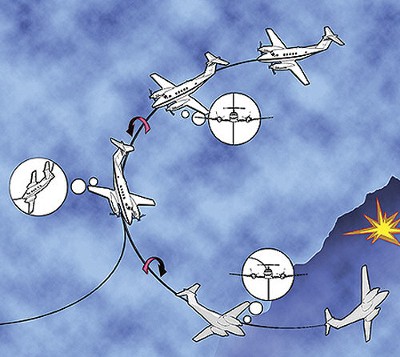DVI’s Spatial Disorientation Experts can evaluate an accident and identify if possible spatial disorientation events took place. The cause of spatial disorientation is when differences or discrepancies between visual, vestibular, and proprioceptive sensory inputs result in a sensory mismatch that can produce illusions. The inner ear contains the vestibular system, which is also known as the organ of equilibrium. About the size of an pencil eraser, the vestibular system contains two distinct structures: the semicircular canals, which detect changes in angular acceleration, and the otolith organs (the utricule and the saccule), which detect changes in linear acceleration and gravity. Both the semicircular canals and the otolith organs provide information to the brain regarding our body’s position and movement. A connection between the vestibular system and the eyes helps to maintain balance and keep the eyes focused on an object while the head is moving or while the body is rotating. Illusions involving the semicircular canals of the vestibular system occur primarily under conditions of unreliable or unavailable external visual references and result in false sensations of rotation.
The Graveyard Spiral is a common spatial disorientation event, and it is associated with a return to level flight following an intentional or unintentional prolonged bank turn. For example, a pilot who enters a banking turn to the left will initially have a sensation of a turn in the same direction. If the left turn continues (~20 seconds or more), the pilot will experience the sensation that the airplane is no longer turning to the left. At this point, if the pilot attempts to level the wings this action will produce a sensation that the airplane is turning and banking in the opposite direction (to the right). If the pilot believes the illusion of a right turn (which can be very compelling), he/she will reenter the original left turn in an attempt to counteract the sensation of a right turn. Unfortunately, while this is happening, the airplane is still turning to the left and losing altitude. Pulling the control yoke/stick and applying power while turning would not be a good idea–because it would only make the left turn tighter. If the pilot fails to recognize this the aircraft will continue turning left and losing altitude until it impacts the ground.

During the investigation of an accident where spatial disorientation is suspected, DVI’s Spatial Disorientation Experts can reconstruct the flight path and examine the radar track data. In some cases, during the evaluation of the flight path reconstruction, in combination with evaluating the weather data for reduced visibility situations, it is possible to identify when the vestibular threshold for the onset of spatial disorientation occurred.




